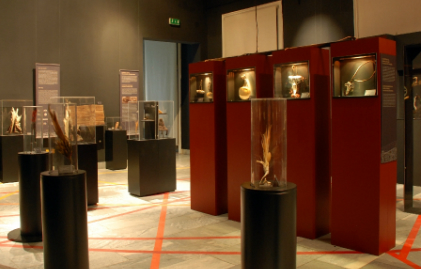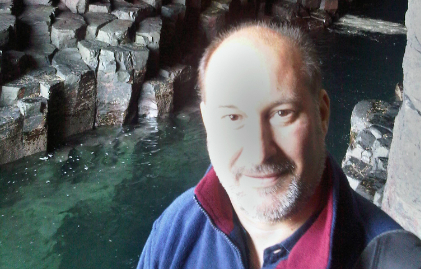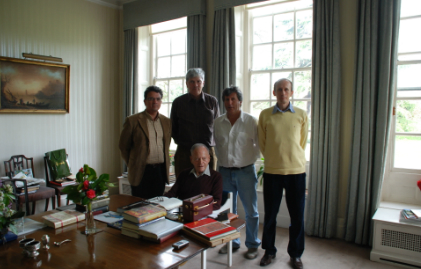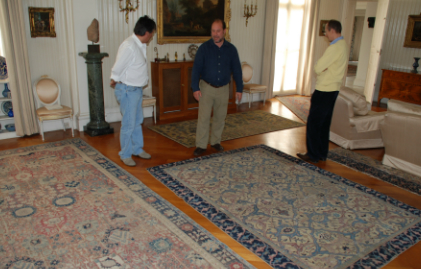The Principles of a Benefactor
Interview with Richard de Unger
What is in the mind of a private collector who lives in London when sponsoring a museum in Hungary? Striking answers, unusual strategies: Richard de Unger
| Gebauer Hanga Klára |
2011-11-14 08:00 |
 A new exhibition titled Jewels from Oceania; The Lajos Bíró Collection was opened in the Museum of Ethnography in Budapest on September 30, 2011. A special guest, Richard de Unger, was present at the opening of the exhibition.
A new exhibition titled Jewels from Oceania; The Lajos Bíró Collection was opened in the Museum of Ethnography in Budapest on September 30, 2011. A special guest, Richard de Unger, was present at the opening of the exhibition.
There was a strong will at the beginning of the 1900s cataloguing the 5600 ethnographical objects collected by Lajos Bíró but it has not been stated until the present years. It is probable that the most beautiful pieces of the Huon Bay Collection would still be in the storerooms of the museum if the De Unger Chair had not been sponsoring their research since 2006. The curator of the exhibition, Anna Biró, has been so successful in her work that Richard de Unger announced his intention at the opening of the exhibition to set up another sponsored researcher position in the Museum of Ethnography.
It is not the first time that a member of the Unger family acts as a benefactor of a museum. The third time great grandfather of Mr. Unger, Mihály Pollack, designed several important buildings, such as the building of the Hungarian National Museum, the Ludovika Academy (now hosting the Hungarian Natural History Museum) and the Museum of Szekszárd (Wosinsky Mór Regional Museum). Several members of the family have been passionate collectors of art even after their immigration to Great-Britain when all their properties had been monopolized by the Hungarian state. One of the most significant members of the family was Richard de Unger’s father, Ödön Unger, who passed away in January. He built up one of the most significant collections of Islamic art in the world.
The Unger family has never stopped to maintain a good relationship with Hungarian museums. According to an article in Index: “Edmund de Unger can be regarded as one of the greatest benefactors of the Hungarian museums. Beside the one-month scholarships provided to several Hungarian curators following the fall of the Communist Regime he also donated several objects to the Hopp Ferenc East-Asian Art Museum in Budapest and sponsored the Hungarian National Museum, as well as the Museum of Applied Arts with more than hundred million forints.” Edmund de Unger, who died at the age of 93 left a exceptional heritage after himself, the Unger Collection of Islamic Art – including ceramics, illuminations, carpets and metal objects – that was put into Trusts several years earlier. Hanga Klára Gebauer and Marianna Berényi made an interview with the older son, Richard De Unger, after the opening of the exhibition.

- Your father left a fabulous collection after himself. What does this heritage mean to you?
My father lived a long life but still I have lost a friend, as well as a father. He was a very good friend, as well as a parent. Our friendship went back as long as the parentage. We were great companions and the bond was our common interests in history, later in collecting family history, little bit of politics, little bit of literature and generally a great sense of humour, which we both enjoyed. Not only did I work for him, I worked with him in business. When he became older I took over with my brother.
- There is a love and passion for collecting art in your family. Can you share the history of the collection with us?
My third time great grandfather, Pollack Mihály, opened the first picture gallery in the Nádor utca, I think it was, where he lived. My grandfather, Richard, was a collector of carpets and knew all the specialists and museum directors of the time. He collected carpets and saw the great exhibition of carpets in Vienna in 1891. That time there was a carpet mania in Budapest, everybody was collecting carpets, Transylvanian carpets came to Budapest, and my grandfather had a great passion for them. My father got his passion for paintings from his father who took him to the Museum of Fine Arts. The first picture he recognised was the Crucifixion of St. Peter. Later when my father had to leave Hungary in 1948 he took with him his love of culture. When you are a refugee, as you know yourself, it doesn’t cost anything to look at a painting, it doesn’t cost anything to look at beauty, and from that he gained a great strength to continue and rebuild his life. So he started to collect carpets again. His house was not so big, so after he had 4 layers of carpets on top of each other, he couldn‘t shut the doors. He decided that he couldn’t continue like this, so he bought a bigger house where he collected Islamic ceramics, paintings.
- How did your father’s interest turn towards Islamic art?
He just loved it. He regarded it as a bridge between western art and Chinese art. It is rather like listening to classical music, you can get the habit of Islamic art, as well. Thirdly, he loved colours. His approach to art was instinctive. It wasn’t an intellectual analysis that came later. The first approach was: “I like it”, “It speaks to me”. And I have got that. That was the most valuable gift he gave to me. I speak all the time to experts and the first thing I ask myself: “Does this expert, does this person really like their subject? Do they really like the pieces?” My father was very scrupulous about pursuing intellectual disciplines, his knowledge was formidable. He could hold his own with any museum director, not just in Islamic art but in western European art and often in Chinese as well. He came from the old school, where you didn‘t specialise in one subject, but it was essential to know generalities of everything.

- What is going to happen to the collection?
The Islamic collection consists of about 2000 objects, the silver collection, the textile collection, the collection of furniture and the collection of paintings. Now his sons are happy enough, or lucky enough to live with a lot of that. And I want to pass on a little bit of what he passed on to me, to my son, and my brother to his children. About the Islamic collection we have signed a long-term agreement with Berlin, hopefully it will succeed. There are some tough obligations on their part. They have to show at least 250 objects and there is a conservation programme, as well. So, the transition is well under way, from private collection to public domain.- Why is it important to you to make the collection available to the public?Generally, so that people could appreciate it. In the past anyone, who was a student or a professor, always had access to the collection. It was always accessible but now it is our hope to be truly accessible.
- Why is it important to you to make the collection available to the public?
Generally, so that people could appreciate it. In the past anyone, who was a student or a professor, always had access to the collection. It was always accessible but now it is our hope to be truly accessible.
- A few years ago you decided that the new place for the collection would be the newly restored Pergamon Museum in Berlin for the next fifteen years but there is a possibility that it will stay there longer, perhaps for thirty-five years. Is it still possible that parts of the collection will be seen in other places?
The agreement with Berlin took 5-6 years to complete and was signed in June 2009. Fortunately my father could see it being signed. Although I negotiated the agreement he was fully aware what was going on, he knew exactly the content of the agreement and he approved it. I have already mentioned Budapest and I would very happily show pieces also in Australia. If the Museum of Perth for example or Sidney wanted to have a permanent exhibition of Islamic art. My main aim is that the collection should be available to the public and not be in the storerooms of the museums.
- Why did you not chose a museum in Britain for the collection?
The reason is that Great-Britain has a huge amount of pieces which duplicate what we have. Out of 2000 pieces probably 1900 are similar or identical. Berlin was chosen because we have what they don’t have and vice versa. Berlin has an obligation to show our pieces, so people could see them and learn the beauty and what Islamic art could teach us.
- The main problems that occur by private collectors are the professional preservation and conservation of the objects. What were the conditions earlier that you could provide to the collection?

In my fathers time, when he purchased the pieces, they had very little commercial value. In some cases he paid a huge amount of money. The pieces mostly had aesthetic value. So conservation wasn‘t the first on his priority list. He loved his objects, he loved to be surrounded by them. They were his friends. They were his trophies. He found them in bazaars. In one case he saw somebody eating yoghurt from an14th century bowl. But I can give you ten stories without even thinking. So these all have associations and memories. Back to conservation: certainly all the windows had ultra-violet protection, people were told not to walk on the carpets and curtains were drawn, but yet it was a home, I grew up there, I played as a child. It wasn’t a museum that was the fundamental difference. Restoration: obviously pieces needed cleaning, restoration, they were done, but they weren’t done in a consistent systematic way as in a museum. My father went to scrap metal merchants in Cairo and found pieces from the 14th and 12th centuries which would be recycled, their value was the value of the metal, not the value of the beauty, so conservation started when he bought them. Saving it if you like, he always told me, that objects used to shout to him: ‚Save me!‘‚Rescue me!‘. So the process started when he bought them. He acquired them, saved them, preserved them and catalogued them. He got the leading experts of the time, and the catalogue was published over 30 years ago about the objects that have stood the test of time.
-What about the objects that remained in your home?
For reasons of security we immediately put the objects into storage after the death of my father. The most difficult thing I had to do in my life was not to bury my father but to take away the pieces from the walls he looked at every day. I kept around 300 objects that I hope to live with since I am a collector as well. I added to the collection the missing parts, or what my father wasn’t interested in: Moroccan pottery – for example – from the 18-19th century that I collected when I was 22-25. I collect other things. I love carpets, Turkish carpets that my father loved and my grandfather loved. If I lost everything overnight, that would be tragic but I derive, I always have pleasure visiting museums and looking at it. But there is a difference between owning a piece or just looking at it. I suppose it is like being married to your life or looking at a beautiful woman. If you are married to your wife you can actually touch the piece, hold it in your hands, you can turn it, hold it to the light and you can contemplate it. In a museum there is always a strict barrier. You can look but you cannot touch. It is what my wife tells me anyway…
- Being a collector is a hobby for you but what do you do when you are not collecting? Do you have a job?
I don’t have a job. Nobody wants to employ me. I’m very happy in that sense. I follow the family traditions. I’m a trained lawyer but I don’t practice, my brother is an accountant, but he doesn’t practice. We are active in various things, such as filmmaking. We are sponsoring a film as a hobby. I primarily do property. I manage properties, which are let, and I managed those or I supervise the management rather. No, the devil is in the detail! You give it to someone else to manage it and you suddenly see that things are not as they should be. I learnt a lesson earlier on in life when I was in the hotel industry. I went round with the manager, and the first thing he did when he went to visit the kitchen in the hotel was not to talk to the chef, the first person he talked to was the person who did the washing up. So I asked him, why do you always talk to the dishwasher? He said: Don’t you know that you can’t put food on a dirty plate! If that plate is dirty it doesn’t matter how good the food is.” I adopted that model throughout my business. I look at the detail, the plate. When that is correct than the rest will follow. If you start at the bottom than you know that the middle management is alright, and if the middle-management is alright than there are some hope that the top is ok too.
- It seems that you are satisfied with your “investment” in Hungary. Is that the reason you are setting up a second sponsored researcher post in the Museum of Ethnography?
It gives me a great pleasure to help this museum, and it gives me a great pleasure to help the museums in Hungary. In Germany and England there are benefactors, and I’m sure too that there is a great will and a great interest for the museums in Hungary as well and I can see that they are very well attended. It gives me great pleasure because it is easier to help here, money goes a lot further here that in England. It is not a criticism of England but what I would give in England to help one person I can help probably four or five in Hungary.
I would like to set up a second person to be helped. Let‘s see how it goes. The Museum of Applied Arts received a large donation from my father. Which I hope they are going to spend on the carpets and carpet restoration. I also hope they will show these carpets because Budapest has, after Istanbul, one of the most important carpet collections of Ottoman carpets in the world. My father gave a large amount of money to the National Museum as well, to purchase things, which I approve but not all the purchases I agree with. There was a case last year of buying part of the Stalin statue, which was torn down in 1956. It wasn’t for political reasons, I could understand the importance of the statue but I thought that Budapest Historical Museum would be a better place to buy it rather than the National Museum, which could have bought something else from different periods of times. But as I said, it is important when you give money to lay conditions and be strict that they are applied to but also you can’t necessarily dictate it. So you also have to give freedom at the same time. It’s a delicate balance between the two. When you give money you should say what it is for but at the same time you should give independence to the people you are giving it to, to show that you trust them, also to use their own initiatives, and of course they know their museum better than you do. So there is a delicate balance between making sure that your money is spent on the right purpose and also preserving an independence of the ones it is going for, so it should be a real partnership.
For reasons of security we immediately put the objects into storage after the death of my father. The most difficult thing I had to do in my life was not to bury my father but to take away the pieces from the walls he looked at every day. I kept around 300 objects that I hope to live with since I am a collector as well. I added to the collection the missing parts, or what my father wasn’t interested in: Moroccan pottery – for example – from the 18-19th century that I collected when I was 22-25. I collect other things. I love carpets, Turkish carpets that my father loved and my grandfather loved. If I lost everything overnight, that would be tragic but I derive, I always have pleasure visiting museums and looking at it. But there is a difference between owning a piece or just looking at it. I suppose it is like being married to your life or looking at a beautiful woman. If you are married to your wife you can actually touch the piece, hold it in your hands, you can turn it, hold it to the light and you can contemplate it. In a museum there is always a strict barrier. You can look but you cannot touch. It is what my wife tells me anyway…
- Being a collector is a hobby for you but what do you do when you are not collecting? Do you have a job?
I don’t have a job. Nobody wants to employ me. I’m very happy in that sense. I follow the family traditions. I’m a trained lawyer but I don’t practice, my brother is an accountant, but he doesn’t  practice. We are active in various things, such as filmmaking. We are sponsoring a film as a hobby. I primarily do property. I manage properties, which are let, and I managed those or I supervise the management rather. No, the devil is in the detail! You give it to someone else to manage it and you suddenly see that things are not as they should be. I learnt a lesson earlier on in life when I was in the hotel industry. I went round with the manager, and the first thing he did when he went to visit the kitchen in the hotel was not to talk to the chef, the first person he talked to was the person who did the washing up. So I asked him, why do you always talk to the dishwasher? He said: Don’t you know that you can’t put food on a dirty plate! If that plate is dirty it doesn’t matter how good the food is.” I adopted that model throughout my business. I look at the detail, the plate. When that is correct than the rest will follow. If you start at the bottom than you know that the middle management is alright, and if the middle-management is alright than there are some hope that the top is ok too.
practice. We are active in various things, such as filmmaking. We are sponsoring a film as a hobby. I primarily do property. I manage properties, which are let, and I managed those or I supervise the management rather. No, the devil is in the detail! You give it to someone else to manage it and you suddenly see that things are not as they should be. I learnt a lesson earlier on in life when I was in the hotel industry. I went round with the manager, and the first thing he did when he went to visit the kitchen in the hotel was not to talk to the chef, the first person he talked to was the person who did the washing up. So I asked him, why do you always talk to the dishwasher? He said: Don’t you know that you can’t put food on a dirty plate! If that plate is dirty it doesn’t matter how good the food is.” I adopted that model throughout my business. I look at the detail, the plate. When that is correct than the rest will follow. If you start at the bottom than you know that the middle management is alright, and if the middle-management is alright than there are some hope that the top is ok too.
- It seems that you are satisfied with your “investment” in Hungary. Is that the reason you are setting up a second sponsored researcher post in the Museum of Ethnography?
It gives me a great pleasure to help this museum, and it gives me a great pleasure to help the museums in Hungary. In Germany and England there are benefactors, and I’m sure too that there is a great will and a great interest for the museums in Hungary as well and I can see that they are very well attended. It gives me great pleasure because it is easier to help here, money goes a lot further here that in England. It is not a criticism of England but what I would give in England to help one person I can help probably four or five in Hungary.
I would like to set up a second person to be helped. Let‘s see how it goes. The Museum of Applied Arts received a large donation from my father. Which I hope they are going to spend on the carpets and carpet restoration. I also hope they will show these carpets because Budapest has, after Istanbul, one of the most important carpet collections of Ottoman carpets in the world. My father gave a large amount of money to the National Museum as well, to purchase things, which I approve but not all the purchases I agree with. There was a case last year of buying part of the Stalin statue, which was torn down in 1956. It wasn’t for political reasons, I could understand the importance of the statue but I thought that Budapest Historical Museum would be a better place to buy it rather than the National Museum, which could have bought something else from different periods of times. But as I said, it is important when you give money to lay conditions and be strict that they are applied to but also you can’t necessarily dictate it. So you also have to give freedom at the same time. It’s a delicate balance between the two. When you give money you should say what it is for but at the same time you should give independence to the people you are giving it to, to show that you trust them, also to use their own initiatives, and of course they know their museum better than you do. So there is a delicate balance between making sure that your money is spent on the right purpose and also preserving an independence of the ones it is going for, so it should be a real partnership.